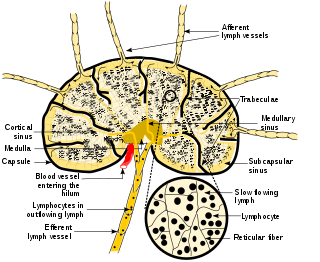Lymphadenectomy or lymph node dissection is the surgical removal of one or more groups of lymph nodes. It is almost always performed as part of the surgical management of cancer. In a regional lymph node dissection, some of the lymph nodes in the tumor area are removed; in a radical lymph node dissection, most or all of the lymph nodes in the tumor area are removed.

Inguinal lymph nodes are the lymph nodes in the inguinal region (groin). They are located in the femoral triangle, and are grouped into superficial lymph nodes, and deep lymph nodes. The superficial lymph nodes have three divisions – the superomedial, superolateral, and inferior superficial lymph nodes.
In human anatomy, the groin is the junctional area between the abdomen and the thigh on either side of the pubic bone. This is also known as the medial compartment of the thigh that consists of the adductor muscles of the hip or the groin muscles. A pulled groin muscle usually refers to a painful injury sustained by straining the hip adductor muscles.

Radical mastectomy is a surgical procedure involving the removal of breast, underlying chest muscle, and lymph nodes of the axilla as a treatment for breast cancer. Breast cancer is the most common cancer among women today, and is primarily treated by surgery, particularly during the early twentieth century when the mastectomy was developed with success. However, with the advancement of technology and surgical skills, the extent of mastectomies has been reduced. Less invasive mastectomies are employed today in comparison to those in the past. Nowadays, a combination of radiotherapy and breast conserving mastectomy are employed to optimize treatment.
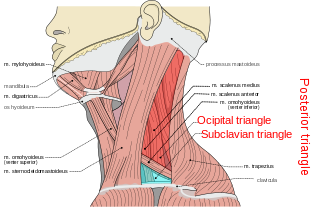
The posterior triangle is a region of the neck.

The external iliac lymph nodes are lymph nodes, from eight to ten in number, that lie along the external iliac vessels.
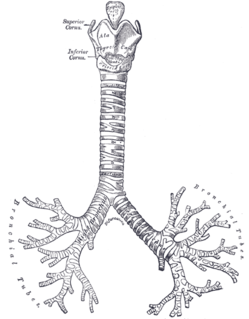
In anatomy, the carina is a ridge of cartilage in the trachea that occurs between the division of the two main bronchi. This occurs at the lower end of the trachea. This ridge lies to the left of the midline, and runs antero-posteriorly. Foreign bodies that fall down the trachea are more likely to enter the right bronchus.

Cervical lymph nodes are lymph nodes found in the neck. Of the 800 lymph nodes in the human body, 300 are in the neck. Cervical lymph nodes are subject to a number of different pathological conditions including tumours, infection and inflammation.

The axillary lymph nodes or armpit lymph nodes drain lymph vessels from the lateral quadrants of the breast, the superficial lymph vessels from thin walls of the chest and the abdomen above the level of the navel, and the vessels from the upper limb. They are divided in several groups according to their location in the armpit. These lymph nodes are clinically significant in breast cancer, and metastases from the breast to the axillary lymph nodes are considered in the staging of the disease.
A brachial lymph nodes are group of four to six lymph nodes which lies in relation to the medial and posterior aspects of the axillary vein; the afferents of these glands drain the whole arm with the exception of that portion whose vessels accompany the cephalic vein.
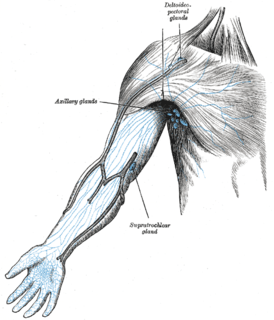
One or two supratrochlear lymph nodes are placed above the medial epicondyle of the humerus, medial to the basilic vein.

Supraclavicular lymph nodes are lymph nodes found superior to the clavicle, palpable in the supraclavicular fossa. The supraclavicular lymph nodes on the left side are called Virchow's nodes.
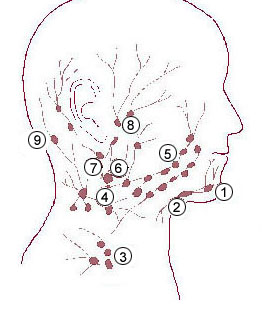
The submandibular lymph nodes, three to six in number, are placed beneath the body of the mandible in the submandibular triangle, and rest on the superficial surface of the submandibular gland.
The AJCC staging system is a classification system developed by the American Joint Committee on Cancer for describing the extent of disease progression in cancer patients.
It utilizes in part the TNM scoring system: Tumor size, Lymph Nodes affected, Metastases.
A mediastinoscope is a thin, tube-like instrument used to examine the tissues and lymph nodes in the area between the lungs (mediastinum) in a procedure known as mediastinoscopy. These tissues include the heart and its large blood vessels, trachea, esophagus, and bronchi. The mediastinoscope has a light and a lens for viewing and may also have a tool to remove tissue. It is inserted into the chest through a cut above the breastbone.

Gliosarcoma is a rare type of glioma, a cancer of the brain that comes from glial, or supportive, brain cells, as opposed to the neural brain cells. Gliosarcoma is a malignant cancer, and is defined as a glioblastoma consisting of gliomatous and sarcomatous components.
A positive axillary lymph node is a lymph node in the area of the armpit (axilla) to which cancer has spread. This spread is determined by surgically removing some of the lymph nodes and examining them under a microscope to see whether cancer cells are present.
Precursor T-lymphoblastic lymphoma is a type of non-Hodgkin lymphoma in which too many T-cell lymphoblasts are found in the lymph nodes and spleen. Also called T-lymphoblastic lymphoma, it is most common in young men.
T-lymphoblastic leukemia/lymphoma, previously labeled precursor T-lymphoblastic leukemia/lymphoma is a form of lymphoid leukemia and lymphoma in which too many T-cell lymphoblasts are found in the blood, bone marrow, and tissues, particularly mediastinal lymph nodes. Labeling as leukemia or lymphoma depends on which feature is more pronounced in a given situation, but has no biological or treatment implication.
